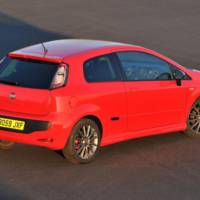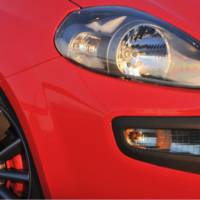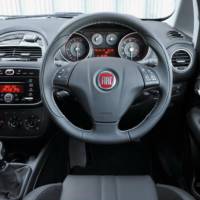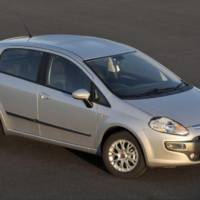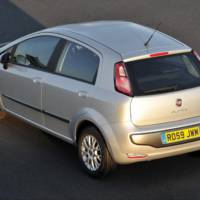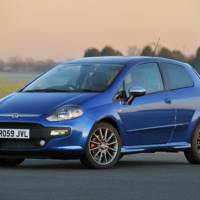The 2010 Fiat Punto Evo price for UK’s market has been announced today along with extensive details regarding improvements and equipment on the newest model.
The 2010 Fiat Punto Evo will be available as a 3-door or a 5-door version and under the bonnet customers will find a wide range of engines with power ranging from 75 horsepower to 135 horsepower. All 2010 Fiat Punto Evo engines feature the MultiAir technology which is an electronic system for dynamic control of air intake plus the Start & Stop system is included as standard.
The 2010 Fiat Punto Evo price for UK starts at 10,995 GBP for the basic Active 1.4 8v 3 door model while the while the most expensive is the Sporting 1.4 MultiAir (135 hp) 3 door variant starting at 15,295 GBP.
Fiat press release :
Think small cars and a string of super-successful Fiats should spring to mind: the ground-breaking 600, the trend-setting 127, the innovative Uno, and progressive Punto.
The Fiat 127, first of the ‘superminis’, was voted Car of the Year 1972 and was destined to become Europe’s best-selling car, continuing in production until the introduction of the Fiat Uno in 1983, by which time a total of 5.6 million had been built.
Compared with the 127, the Uno was some 6cm shorter and a similar amount taller. Voted Car of the Year 1984, it was also destined to be Europe’s best-seller, with no less than 2.5 million sold in just four years, and a total production run of more than six million.
Its successor, the Punto, was another Car of the Year winner, in 1995, and more than seven million would be produced worldwide, including over 650,000 sold in the UK. In Grande Punto guise it is still Europe’s fifth best-selling car.
Now the new Punto Evo is set to build on the strengths of its illustrious predecessors and move the game on with a host of innovations.
To cater for customers who are more demanding than ever, the Punto Evo has been designed to meet the requirement for smaller, more environmentally friendly cars that are easier to park and more affordable to run, yet still stylish, safe, comfortable and fun to drive. Fiat has managed this by combining ground-breaking new engines with a healthy dose of technology and features traditionally associated with larger cars.
As a dynamic development of the popular Grande Punto, the Punto Evo has a bold new look inside and out, cloaking a stronger structure that makes it safer, better to drive and more welcoming for passengers. And it incorporates many advanced safety features to further enhance the ownership experience, including knee airbags, double seatbelt pre-tensioners and ESP with hill holder.
This is typical of the high specification levels that owners of the Punto Evo will enjoy. In line with Fiat’s philosophy of technology-for-all, every model in the range is fitted with the firm’s Blue&Me interface that allows drivers intuitive control of all the car’s major functions. And all models, except Active, can be specified with the cutting edge Blue&Me TomTom system.
This means fingertip access to a touch-screen navigation system, mobile phone, trip computer and MP3 player with steering wheel commands. It also includes Fiat’s ground-breaking eco:Drive which helps owners lower their fuel consumption and exhaust emissions. For the first time, eco:Drive is a fully integrated system in Punto Evo, and customers can now receive real-time suggestions for more environmentally friendly motoring.
But this car’s launch is made particularly noteworthy because it heralds the unleashing of two important new ‘Ecotechnology’ engine line-ups, the MultiAir petrol family and MultiJet II diesels.
The Punto Evo’s range of five engines all conform to Euro 5 emissions requirements and are all fitted with Start&Stop technology as standard. But improved fuel consumption isn’t the only way in which Punto Evo owners will benefit from its innovative engines. Low CO2 emissions mean customers will also pay low levels of Vehicle Excise Duty (Car Tax) – just £35 in the case of the new Punto Evo MultiJet range.
Whichever engine customers choose, they’ll have two different chassis philosophies and five trim levels to deliberate over. All the GP and exclusively three-door Sporting versions follow the Sport chassis philosophy with racy on-road behaviour and more assertive looks. Three or five-door Comfort versions come in either Active, Dynamic or Eleganza trims with a more elegant look and feel to them.
Even the entry level Active model features a generous amount of standard equipment including front driver, passenger and driver’s knee airbag, five standard-size seats, two rear head restraints, front electric windows, height and reach adjustable steering wheel, electric mirrors, and Blue&Me infotainment. Owners can also choose from an extensive options list, and with a total of 22 versions to select from at launch, (a 1.6 16v MultiJet 120bhp version joins the range in October), customers will find plenty to interest them in the new Punto Evo range.
Small-car costs; big-car comfort
The Punto Evo has been conceived to cosset its occupants as a larger car might. This has been achieved through a clever combination of factors.
Most noticeably the car’s interior design has been substantially reworked. Hard angles have been abandoned and replaced with softer, curvier lines that appear plush and elegant, giving a cosier, more comfortable atmosphere.
Work by Fiat’s famed Centro Stile (Style Centre) has concentrated on finding and fitting materials that don’t just look good, but feel good too. And a radical redesign inside has halved the size of the centre console. At the top of this now sits a recess where the portable Blue&Me TomTom unit is situated just above the air vents (not on Active). A classy piano black panel surrounds the sound system’s LCD display and includes buttons for functions such as the central locking set into it.
Below this, some versions have a diffused ambient light source which can be switched on at night to bathe the interior in a mellow shade, making driving in the dark a real event. Beneath this is a separate console to house the ventilation controls.
The instruments feature larger dials for the speedometer and rev counter, and these sit within a new cowl that shades them from bright light. The instrument panel features a gear shift indicator (GSI), which advises drivers when to change to a higher or lower gear, depending on conditions, and a ‘real time’ indication of consumption.
Seats too have been redesigned to improve them ergonomically and a new range of innovative materials are being used on these and the door panels to ensure the Punto Evo feels absolutely contemporary.
This high tech approach is fully in keeping with the latest generation Blue&Me TomTom that any Punto Evo, except Active, can be specified with. Despite being cheaper to fit than rivals’ systems, this in-car interface is more versatile and user friendly. It is simple to use, offering easy access to information.
With Blue&Me TomTom in fact, a completely integrated infotainment system is created which allows for the management, via a modern colour touch-screen, of telephone, navigation and all the information necessary for driving. Thanks to dashboard provision, management via steering wheel controls and voice instructions, it is possible to ensure maximum safety when driving. This new system will also supply drivers with information in real time concerning the environmental impact of their own driving style, and will suggest how to perfect it through correct handling of gear changes and use of the accelerator pedal.
Featuring a 4.3-inch high-resolution touch screen, the portable unit links to the car via an integrated connector on the dash, meaning that there are no trailing cables or wires. Mobile phone, sound system, trip computer and navigation are all controlled via the screen. As it can monitor traffic conditions, the navigation system picks the most convenient route. The unit also employs Bluetooth and advanced voice recognition to allow you to control all functions either from the steering wheel or with your voice. This fully portable screen can be removed from the car and used in any other vehicle, with suction pads to hold it in place.
Blue&Me TomTom works in conjunction with Fiat’s incredibly popular eco:Drive software. Downloading this from the Fiat website enables owners to use the in-car USB port to transfer information about their driving to a PC. They can then request an assessment of their skills at the wheel, compare themselves with others and progress through a series of tutorials to make their driving style more environmentally sound.
Thanks to Blue&Me TomTom, however, eco:Drive information and suggestions about reducing the environmental impact of driving now appear in real-time on the in-car screen. And should the fuel reserve warning light come on, directions to the nearest filling station can be immediately requested. This is the sort of solution to motoring hassle that the Punto Evo has been designed to offer.
But in-cabin technology isn’t the only tool Fiat has used to make the Punto Evo’s cockpit an enjoyable place to be. Engineers have also been hard at work on the car’s structural characteristics. Rigidity has been improved and new flexible suspension bushings, optimised to suit the new engines, have been exploited to reduce noise and vibrations transmitted from the road surface.
New soundproof roof panelling has also been employed with thermo-expandable panels to reduce driving noise. Diesel models use a laminated PVB windscreen and have an engine cover. The overall result is a significant reduction of in-car noise, while these alterations have also improved the tone and quality of the engine’s sound to the outside world.
Drive the Evolution
As well as being the thrust of the advertising campaign for the Punto Evo, ‘Drive the Evolution’ sums up how the entirely revised or new engine line-up will propel Fiat into an ever more environmentally friendly future.
The Punto Evo heralds the launch of two all-new engine ranges, the petrol MultiAir, and MultiJet II diesel models. On top of this, all versions feature Start&Stop where the engine shuts down instead of idling when the car is at a standstill, but bursts back into life when you need to get underway again.
The range starter is the 1.4-litre eight valve 77bhp engine which, like every other engine in the 22-strong range, now complies with Euro 5 exhaust emissions legislation. The other petrol units feature Fiat Powertrain Technologies’ unique and ground-breaking MultiAir expertise – a technological leap forward that is to be rolled out across the company’s entire fleet of models.
MultiAir
In conventional combustion engines, air charge through the intake valve is controlled by the rotation of a camshaft via a simple throttle. The main disadvantages of this system are a waste of energy and a slow adjustment to the continuously changing demands of differing driving conditions.
MultiAir is Fiat’s new electronic system for dynamic control of air intake, cylinder by cylinder, stroke by stroke. This electro-hydraulic valve actuation technology is based on the use of a high pressure oil chamber between the camshaft and the intake valve, managed by a solenoid valve connected to an ECU. This way, valve lift schedules become extremely flexible and vary precisely and immediately according to engine air requirements.
Various factors are used to optimise combustion efficiency, with remarkable benefits in terms of power, torque, fuel consumption and emissions. Complete valve opening, or full lift – the current mode of conventional engines – is used by MultiAir only when full engine power is required. At engine start-up, and when idling, late intake valve opening determines a higher air speed intake, thereby optimising the mixture formed, and its combustion.
At medium to low RPM, moderate torque demands and partial engine load, early intake valve closing optimises volume efficiency and reduces pumping losses. Undesired backflow into the manifold is avoided, and air mass trapped in the cylinder optimised. Multiple valve opening, or multi-lift, at low engine speeds or from idle, allows for an optimisation of combustion control.
Euro 5 compliant (and Euro 6 ready); easy start characteristics; electronic management; low fuel consumption; a high fun-to-drive quotient; immediate dynamic response; maximum performance… these are some of the innumerable advantages of MultiAir, thanks to electronic control that adjusts air intake parameters precisely according to road conditions and driving mode.
During cold starts, the MultiAir system optimises air intake based on the external temperature, with engine start-up guaranteed in any conditions. Lower fuel consumption and more relaxed driving in heavy traffic are additional benefits of MultiAir technology. Exhaustive driving tests have repeatedly shown clear advantages in terms of higher torque and power, allied to a notably superior driving experience and vastly improved engine dynamic response.
In summary, MultiAir optimises engine intake air over the entire RPM range, with an ensuing reduction in fuel consumption by an average 10 per cent, thanks to the dramatic reduction of pumping losses and the exact grading of the parameters which perfect combustion.
MultiAir also provides for an average 10 per cent reduction in CO2 emissions; 10 per cent power increase; and 15 per cent torque improvement.
At the same time, toxic emissions are dramatically reduced, (40 per cent of HC/CO and 60 per cent of NOX), in the engine warm-up phase thanks to the perfecting of strategic valve control during the engine inlet phase, and internal exhaust recycling obtained by reopening the inlet valve during the exhaust phase.
MultiAir technology is the outcome of striking research efforts by Fiat Powertrain Technologies – an authentic innovation for all internal combustion engines.
What this means is that the 105bhp 1.4-litre MultiAir unit in the new Punto Evo emits just 134g/km of carbon dioxide along with 49.5mpg (Combined Cycle) fuel economy, yet offers lively performance and a 0-62mph acceleration time of just 10.8 seconds.
The range-topping 135bhp 1.4-litre MultiAir Turbo is even more impressive. With almost 100bhp per litre at the driver’s command, this delivers a petrol engine benchmark for acceleration with a 0-62mph time of 8.5 seconds, yet also offers combined cycle fuel consumption of a remarkable 50.4mpg and a CO2 figure of just 129g/km.
MultiJet II
Fiat has a proud history of leading the world when it comes to diesel power. Fiat was first with a direct injection diesel in a production saloon car in the 1980s, and in the 1990s there was Common Rail – a Fiat invention. Then in 2003, Fiat’s MultiJet was the first to improve the thermodynamic efficiency of the engine by introducing five injections during the same combustion cycle. Now, for its latest generation of cars and light vans, Fiat has further improved the 1.3 MultiJet, and Punto Evo is the perfect showcase.
Thanks to a new balanced solenoid servo valve, MultiJet II is able to control with high precision, the quantity of fuel injected into the cylinder, with a quicker and more flexible injection sequence. In fact, the new MultiJet II system can manage eight injections per cycle.
It also offers higher flexibility in managing multiple injections, resulting in further optimisation of diesel combustion. In particular it has a new injection modality called Injection Rate Shaping (IRS) which consists of two consecutive injections with zero hydraulic dwell. This has a positive effect on combustion at higher loads, allowing for improved trade-off in terms of emissions, fuel consumption and noise.
It all means that the second generation 1.3-litre MultiJet provides the driver with an engine that complies with Euro 5 emissions legislation, yet in 95bhp form gives Punto Evo a 0-62mph acceleration time of 11.7 seconds while returning 67.3mpg (combined cycle) and emitting just 110g/km of CO2. When combined with Fiat’s Dualogic gearbox, consumption is boosted to 68.9mpg and emissions fall further, to 107g/km.
MultiJet II is also available as a 75bhp unit and, like the higher power version, is Euro 5-compatible, comes with Start&Stop and features a Diesel Particulate Filter. These engines also employ second generation turbochargers (with variable vane geometry in the more powerful version) which, along with the MultiJet II injection system, ensure the best possible turbo function at any engine operating level. The big advantage they have over the outgoing Euro 4 engines is that torque delivery at low revs can be up to 25 per cent greater.
Depending on the engine there’s a choice of five or six-speed manual gearboxes, or a Dualogic robotised sequential shift which has been optimised for manoeuvrability and low noise levels. And it makes the Punto Evo the only car among its peers to feature an automatic gearbox alongside Start&Stop.
Full of high-tech ideas
Punto Evo is an evolution of the highly successful Grande Punto, and as such features a host of exciting and innovative equipment that not only builds on the heritage of the previous Punto family, but moves this new model on a stage further.
The many ideas introduced to the Punto Evo turn this new car’s evolution into something of an electronic revolution. They include:
Sensors:
Rain: An infrared LED installed on the front screen of the car senses the presence of rain and operates the windscreen wipers, depending on how much water is present on the window.
Parking: Punto Evo’s parking aid system provides drivers with information on the distance from obstacles behind the vehicle, and outside their field of vision, when reversing.
ESP with Hill Holder:
Punto Evo is the only B segment car with this feature. The system combines information collected by sensors from the pedal board, gear shift and engine control centre, and supplies the braking torque necessary to keep the car at a standstill on a slope until the driver releases the clutch to move off.
Navigation and Infotainment:
Fingertip access to navigation and infotainment: Thanks to dashboard provision, management via steering wheel controls and voice instructions, it is possible to ensure maximum safety when driving. This new system will also supply drivers with information in real time concerning the environmental impact of their own driving style, and will suggest how to perfect it through correct handling of gear changes and accelerator pedal.
Start&Stop:
Designed specially for urban or congested route use, the Start&Stop system automatically turns off the engine when traffic conditions impose stopping the vehicle: the gear lever only has to be placed in neutral when the car is at a standstill and the engine stops, while ensuring the continuation of normal functions which guarantee on-board comfort and safety, such as, for example, use of the climate control system, listening to the radio and windscreen wiper operation. As soon as the driver operates the clutch pedal to engage a gear, the engine restarts immediately.
Lighting:
Adaptive cornering foglights, lane change warning, daytime running lights and ‘Follow Me Home’ lighting are all features included in new Punto Evo.
MultiAir and MultiJet technology:
The range of Punto Evo engines includes both Fiat’s MultiAir petrol and second generation MultiJet II diesel engines. All power plants adopted by Punto Evo have been created for the right balance between expectations of performance, fuel consumption, low emissions, and comfort.
eco:Drive:
Fiat’s innovative eco:Drive system for monitoring the driver’s style and environmental impact, is available ‘real-time’ for the first time in a Fiat car, so that drivers can check their eco:Drive rating while on the move.
No sacrifices over safety or style
As with every Fiat, a priority with the Punto Evo is to provide protection for all the family. As standard, every version comes with driver and passenger airbags, together with front and rear adjustable head restraints and it’s one of the few cars in its class to feature a driver’s knee airbag at no extra cost.
Also rare for a car of this size are the optional adaptive front fog lights which switch on automatically, left or right, to illuminate the apexes of bends when negotiating low speed corners. This feature is activated under 40km/h (28mph). Additionally, Punto Evo features Daytime Running Lights (DRL). These front headlights are not designed to light the road but to make the car more visible. They use special bulbs with lower power than those in dipped beam headlights, and are switched on automatically by the ‘key-in’ from the dashboard. Using them does not reduce the luminosity of the dashboard instrumentation which therefore remains clearly visible.
The front fog lights are also used for another Punto Evo safety feature – lane change warning. When indicating to move from one lane to another, the appropriate fog light flashes once at the same time as the first indicator ‘blink’. This feature makes the car even more visible to other traffic during this potentially dangerous manoeuvre. All-new rear lights guarantee that the car is more visible to other road users at night.
On the road there is a powerful and effective braking system supplemented by the latest electronic dynamic control systems. So there’s ABS anti-lock braking with Electronic Brakeforce Distribution (EBD) and Electronic Stability Program (ESP) with Hill Holder to assist with starting off on a slope. The Punto Evo is the only car in its class to have this latter feature available across the entire range.
In addition to these innovations, there are various options aimed at making driving less tiring, such as climate control, rain sensing windscreen wipers and cruise control.
The Punto Evo proves that just because a car is safe, customers shouldn’t have to scrimp on style. Consequently there have been significant changes to the exterior such as a new front bumper and radiator grille styles which contain the direction indicators and adaptive cornering fog lights.
At the rear there’s a new bumper to incorporate the number plate, those distinctive rear lights, and the centrally-placed Fiat logo that doubles as a boot release. The new bodywork stretches the Punto Evo by 3cm to 406cm, although other dimensions of width, height and wheelbase remain the same as the Grande Punto.
There are also subtle pointers to make distinguishing between different models in the range easier. Sport versions have a hexagonal mesh grille and dark line with an embedded Fiat logo. Comfort models feature a linear-style grille and chrome-coloured line. Headlights are framed dark for Sport models, in chrome for Comfort. And the logo on the tailgate changes according to the model. The Punto Evo’s dot is red for the high performance 135bhp petrol, and black for other engine types. It’s a neat touch that encapsulates the attention to detail, thought and engineering know-how that has gone into producing the new Fiat Punto Evo.
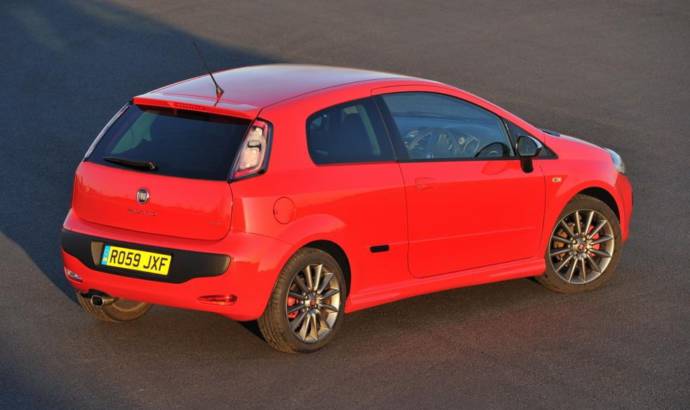
22 Jan 2010
0

